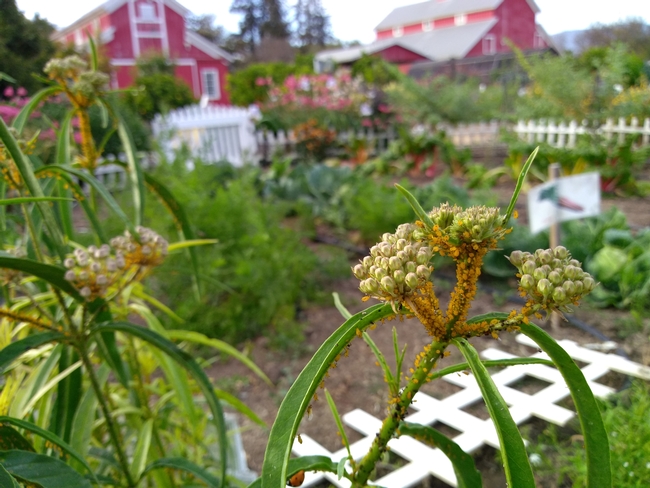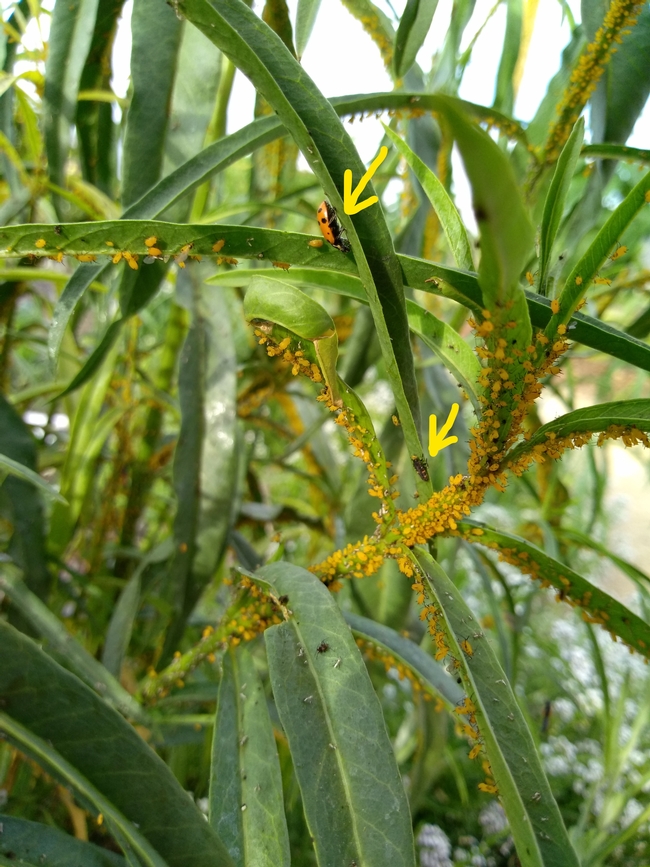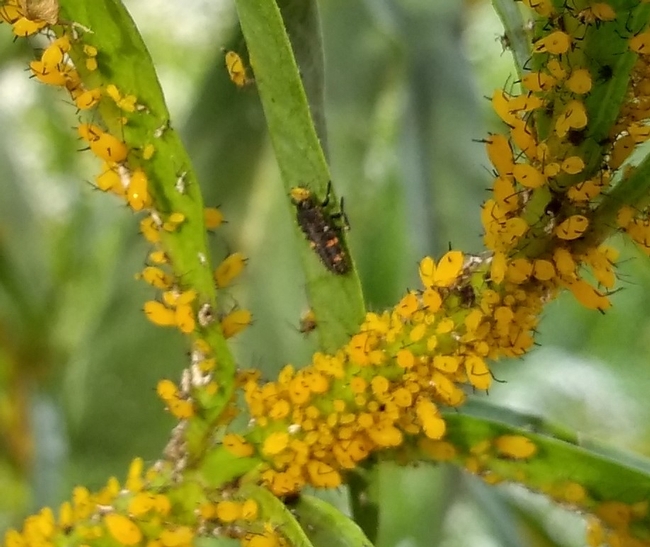
Amazing aphids: strength in numbers
In this weekly blog, Dr. Annemiek Schilder, Director, UCCE Ventura County and Hansen Agricultural Research and Extension Center, shares her observations about the natural world across the seasons. As she says:
"Gently observing your surroundings with curiosity will teach you some amazing things. There are so many fascinating things happening under our noses, only wanting for an observant eye."
During a recent stroll through the Master Gardener Demonstration garden at the Hansen Agricultural Research and Extension Center, a narrow-leaf milkweed plant with stems and leaves covered in yellow caught my eye. A closer look revealed teeming masses of yellow aphids along the stems, as if festively dressing up the plant. But aphids are never a festive sign to the gardener as their voracious feeding stunts plant growth. In addition, their sugary excretions may attract ants and promote unsightly fungal growth called sooty mold.

Narrow-leaf milkweed (Asclepias fascicularis) is a perennial plant native to California and an important food source for the caterpillars of monarch butterflies along their migration route. Milkweed plants produce chemicals called cardenolides (cardiac glycosides) that monarchs store in their bodies to protect themselves from predators. Can you guess what part of the body these chemicals act on? Indeed cardenolides speed up the heart rate, making for a rather unpleasant experience for a bird looking for a tasty meal. Narrow-leaf milkweed plants actually have very low levels of cardenolides, but the monarch's striking color pattern is enough to signal toxicity to would-be predators.
Aphids make milkweed plants less hospitable for monarch caterpillars. The striking yellow aphids −Aphis nerii, also called milkweed aphids or oleander aphids−feed on plants in the dogbane family, including oleander, milkweed and periwinkle. They have a yellow pear-shaped body with black legs, antennae and cornicles. Cornicles are the stovepipe-like projections on the aphid's back used to secrete a wax-like substance for self-defense. Aphids are typically wingless until they get too crowded and develop winged individuals that fly away in search of new host plants.
Aphids feed by inserting their mouth parts, which are shaped like a straw, into the plant, sucking up plant sap which contains all the necessary nutrients for the aphid to thrive. The extra sugar and water are excreted as honeydew. Milkweed aphids are able to rapidly colonize plants in the spring and early summer through parthenogenesis, a process whereby female aphids produce female offspring without mating. The aphid daughters, which are exact clones of their mothers, quickly start producing their own babies. In addition, they bypass the egg laying phase by giving birth to live young, which is called vivipary. Looking through a magnifying glass, you may see the little baby aphids being born right in front of your eyes!

As I was taking some close-up photos, I noticed the aphids intermittently twitching, almost in unison. This strange phenomenon, exhibited by this particular aphid, is called CTKR (Collective Twirling and Kicking Response). It is a collective defense mechanism against natural enemies! By simultaneously twirling their bodies and forcefully kicking their hind legs they discourage natural enemies like parasitoid wasps from attacking them. If you look closely, especially later in the season, you may see evidence of this type of parasitism: little puffed-up aphid bodies with a hole in the middle. These aphids have been parasitized by a wasp larvae which molted into adults and escaped through the hole.
Aphids are like sitting ducks: they usually remain in place while feeding. They will only move if their food runs out or something is irritating them. That makes them a convenient prey for the lady beetle, a very effective natural enemy. In the picture, you can see an adult lady beetle as well as a lady beetle larva, which looks like a tiny black alligator, feeding on aphids. They can eat hundreds of aphids per day and thousands in a life time! Lady beetles are good friends indeed.

Related Reading:
What's wrong with my peach tree?
UC HAREC donates fruits and vegetables
